|
|
|
Sort Order |
|
|
|
Items / Page
|
|
|
|
|
|
|
| Srl | Item |
| 1 |
ID:
061770


|
|
|
|
|
| Publication |
Apr 2005.
|
| Summary/Abstract |
As we have become dependent on the internet, as the ‘network of networks’, so we have become vulnerable to criminal and terrorist networks that use cyberspace as a means to undermine and circumvent state control. Protecting against those that wish to attack the integrity, confidentiality and availability of systems, and the data they process, is primarily an issue of implementing appropriate security measures. But how do governments react to such threats against social and economic stability? This article examines recent inter-governmental harmonisation initiatives addressing the suitability of the criminal code, the adequacy of law enforcement powers to investigate cyberspace activities and the need for greater transnational co-operation. Such reforms challenge some traditional conceptions of state control and authority and can be seen as threatening existing rights and interests.
|
|
|
|
|
|
|
|
|
|
|
|
|
|
|
|
| 2 |
ID:
119503


|
|
|
|
|
| Publication |
2013.
|
| Summary/Abstract |
There have been growing claims in media circles and law-enforcement settings that street gangs and criminal groups are turning to Internet-based social networking sites for various reasons ranging from the showcasing of their images and exploits to the suspected recruitment of members. The present study investigates whether such a trend is, in fact, in place. The presence of street gangs on these Internet sites is referred to as cyberbanging. While there is some anecdotal evidence suggesting that gangs are turning to social networking sites, there is little available research on exactly how street gangs and criminal groups use the Internet. Our main argument is that gang culture is in many ways an individualized phenomenon and this feature ties in directly with recent assessments of the Internet as a setting that is governed by a process of networked individualism. This theoretical link between the individualized gang setting and the presence of gang members on social networking sites helps us understand why recruitment is improbable even in a context where people are openly diffusing their image and exploits to a growing number of Internet users. The empirical segment of this research adds to this general outlook. Based on a keyword search of over 50 street gang names, the three main social networking sites (Twitter, Facebook, and MySpace) were monitored for street gang presence. Results illustrate that gang presence on social networking sites is linked primarily to promoting a general gang or street culture through individual displays. In regard to the visitors to such sites, there is no evidence that they are being tricked or manipulated in any way. They are, however, showing their curiosity in regard to such groups and, for those who share their comments and opinions, signs of support are evident. Thus, whereas criminal gangs are not proactively using the Internet to convert anyone into being gang members, social networking sites are creating a new venue for people who share or are sensitive to the values underlying street gang lifestyle to come together. These sites essentially create a new convergence setting for gang members to interact with a wider number of people who would probably never have been exposed to their lifestyles and exploits through physical interactions. The study's conclusion extends these findings toward further research in this area, as well as outlining the more relevant implications for law-enforcement monitoring of this growing phenomenon.
|
|
|
|
|
|
|
|
|
|
|
|
|
|
|
|
| 3 |
ID:
126186
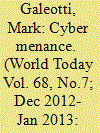

|
|
|
|
|
| Publication |
2012-13.
|
| Summary/Abstract |
Computer crime could soon pose a greater threat to world security then terrorism. Mark Galeotti analyses the problem and looks at the ambivalent attitude of states towards countering it.
|
|
|
|
|
|
|
|
|
|
|
|
|
|
|
|
| 4 |
ID:
107766
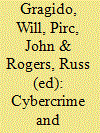

|
|
|
|
|
| Publication |
Amsterdam, Elsevier, 2011.
|
| Description |
xi, 254p.
|
| Standard Number |
9781597596131, hbk
|
|
|
|
|
|
|
|
|
|
|
|
Copies: C:1/I:0,R:0,Q:0
Circulation
| Accession# | Call# | Current Location | Status | Policy | Location |
| 056256 | 364.168/GRA 056256 | Main | On Shelf | General | |
|
|
|
|
| 5 |
ID:
190929
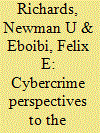

|
|
|
|
|
| Summary/Abstract |
Cybercrime investigators, in an attempt to rid Nigeria of cybercrime, go about arresting and demanding for digital devices, of unsuspecting members of the public, especially Nigerian youths. Upon seizing these digital devices, they compel the owners to surrender security features to gain access to the devices to fish for cybercrime evidence. The rampant nature of this investigative process partly culminated in the recent ‘ENDSARS’ protests in Nigeria that commenced in cyberspace with the hashtag #ENDSARS NOW. Although the ENDSARS protest has become a topic of discourse in the news, literature, and academic domain, there seems to be limited or no literature on the cybercrime perspectives of the protests. This paper seeks to answer the question: To what extent can cybercrime investigators legally gain access to digital devices and social networks of persons? It concludes that to avoid future protests against cybercrime investigators, implementing a structured cybercrime investigation process in conformity with best practices, as it is done in developed economies like the United States of America, is suggested.
|
|
|
|
|
|
|
|
|
|
|
|
|
|
|
|
| 6 |
ID:
141532
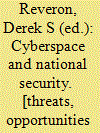

|
|
|
|
|
| Publication |
New Delhi, Satyam Law International, 2013.
|
| Description |
ix, 246p.: ill.pbk
|
| Standard Number |
9789382823001
|
|
|
|
|
|
|
|
|
|
|
|
Copies: C:1/I:0,R:0,Q:0
Circulation
| Accession# | Call# | Current Location | Status | Policy | Location |
| 058334 | 355.033002854678/REV 058334 | Main | On Shelf | General | |
|
|
|
|
| 7 |
ID:
178932


|
|
|
|
|
| Summary/Abstract |
Over the last two decades, there has been a massive increase in research examining terror and extremist-related violence. Few have considered the extent to which these same groups may engage in attacks against digital infrastructure and the Internet, whether through hacking or other methods. The absence of empirical evidence calls to question the nature and dynamics of cyberattacks performed by extremists and ideologically motivated actors. This study attempted to address this gap in the literature through a qualitative investigation of 26 attacks performed by far-left groups against targets in the UK, US, and Canada from 2000 to 2015. This data was compared to physical attacks documented in the Extremist Crime Database during the same period. The findings demonstrated that there was an increase in cyberattacks during a period of decreased physical violence by far-left groups. Additionally, there was some parity in the targets of far-left groups on- and off-line, with similar motivations to cause harm to or embarrass businesses, government organizations, and individuals. The implications of this study for our understanding of terror and future research were discussed in detail.
|
|
|
|
|
|
|
|
|
|
|
|
|
|
|
|
| 8 |
ID:
188079
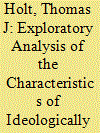

|
|
|
|
|
| Summary/Abstract |
Web defacement is a form of hacking that involves altering the content of a website, resulting in repairs to the website code, loss of revenue, internal loss of productivity, and reputational damage. Limited research has examined the frequency of web defacements, the factors that distinguish them from other hacking motives, and the extent to which the correlates mirror research on physical acts of ideologically-motivated crime. The current study examined over 2.4 million web defacements hosted in the U.S. from 2012 to 2016 to assess aspects of routine activities theory associated with target selection and attack methods among ideologically-motivated defacements. A binary logistic regression analysis revealed that ideologically-motivated defacers were more likely to use unknown vulnerabilities; engage in repeated attacks; target top-level domains linked to foreign nations; domains ending in.edu; and homepages within websites. The findings of this study suggest that the target selection process of ideologically-motivated defacers are more purposive and designed to draw attention to their cause, resembling target preferences of individuals who engage in physical violence in support of an ideological agenda.
|
|
|
|
|
|
|
|
|
|
|
|
|
|
|
|
| 9 |
ID:
112620
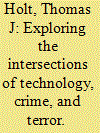

|
|
|
|
|
| Publication |
2012.
|
| Summary/Abstract |
The Internet and computer-mediated communications (CMCs) have drastically changed the way that individuals communicate and share information across the globe. Over the last two decades, financial institutions, private industry, and governments have come to rely on technology in order to access sensitive data and manage critical infrastructure, such as electrical power grids. As a consequence, the threat posed by cybercriminals has increased dramatically and afforded significant opportunities for terrorist groups and extremist organizations to further their objectives. The complex and intersecting nature of both crime and terror make it difficult to clearly separate these issues, particularly in virtual environments, due to the anonymous nature of CMCs and challenges to actor attribution. Thus, this study examines the various definitions for physical and cyberterror and the ways that these activities intersect with cybercrime. In addition, the ways that terrorists and extremist groups use the Internet and CMCs to recruit individuals, spread misinformation, and gather intelligence on various targets are discussed. Finally, the uses of computer hacking tools and malware are explored as a way to better understand the relationship between cybercrime and terror.
|
|
|
|
|
|
|
|
|
|
|
|
|
|
|
|
| 10 |
ID:
182914
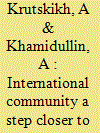

|
|
|
|
|
| Summary/Abstract |
THE COVID-19 pandemic has forced the world to plunge into the virtual space and to digitalize economic and everyday life. Crime, having rapidly adapted to the new conditions, has rushed to take advantage of information and communication technologies (ICTs). Phishing, ransomware, DDoS attacks, and cyberattacks are constantly in the news and have become part of our everyday lives. In an era of unrestrained digitalization, computer attacks could have devastating consequences and lead to disasters related to national security. Meanwhile, the activities of cyber criminals are still mostly aimed at seeking financial gain. The pandemic has given them a new impetus and exposed long-standing issues. They are largely related to the shortcomings of states' national legislation and the current system of international cooperation in this area. The existing multilateral instruments were elaborated 10 to 20 years ago and objectively are not keeping pace with cybercrime activity. Bilateral communication channels between states' law-enforcement agencies are far from perfect. It is especially noticeable when crimes are committed within just a few minutes, while it can take from a few weeks to two to three years to receive a response to a request for electronic evidence...
|
|
|
|
|
|
|
|
|
|
|
|
|
|
|
|
| 11 |
ID:
191500
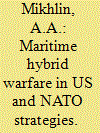

|
|
|
|
|
| Summary/Abstract |
This paper elucidates the essence and content of possible maritime hybrid warfare of the US and NATO against Russia based on a unified system of new challenges and threats: terrorism at sea, piracy, drug trafficking, illegal migration, cybercrime, etc. It also proposes some preventive countermeasures to ensure the security of maritime economic activities of the Russian Federation (RF).
|
|
|
|
|
|
|
|
|
|
|
|
|
|
|
|
| 12 |
ID:
085066
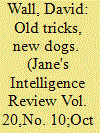

|
|
|
| 13 |
ID:
137988
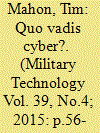

|
|
|
| 14 |
ID:
180742
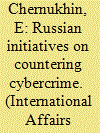

|
|
|
|
|
| Summary/Abstract |
THE DIGITAL revolution that began a few decades ago provides tremendous development opportunities to nations, but also creates more opportunities for criminals and makes crime more complex and sophisticated.
|
|
|
|
|
|
|
|
|
|
|
|
|
|
|
|
| 15 |
ID:
139729
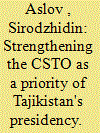

|
|
|
|
|
| Summary/Abstract |
IN THE PRESENT-DAY international situation, security has become a paramount concern. The end of the Cold War era brought about deep changes in global politics, which led to a new quality in the system of international relations. The threat of a global nuclear catastrophe gave way to new challenges, such as international terrorism, religious extremism, organized crime, drug trafficking, and cybercrime.
|
|
|
|
|
|
|
|
|
|
|
|
|
|
|
|
| 16 |
ID:
113384
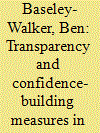

|
|
|
| 17 |
ID:
112629
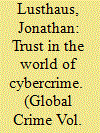

|
|
|
|
|
| Publication |
2012.
|
| Summary/Abstract |
For cybercriminals, the anonymity of the Internet offers not only opportunities but also challenges. Where one does not truly know whom one is doing business with, it makes it difficult to assess trustworthiness or to retaliate should dealings go sour and agreements need to be enforced. This creates a large deficit of trust, beyond even that common among conventional criminals, and makes cybercriminal transactions very unstable. As a result, it might be expected that cybercriminals would often act alone. But, in reality, cybercriminals collaborate quite widely. This is the puzzle that this article addresses. In order to overcome the major challenges of online anonymity, and to capitalise on its benefits, cybercriminals have developed a range of mechanisms that buttress trust. These include mechanisms relating to (1) establishing cybercriminal identities; (2) assessing cybercriminal attributes; and (3) extra-legal governance.
|
|
|
|
|
|
|
|
|
|
|
|
|
|
|
|
| 18 |
ID:
129987
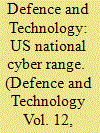

|
|
|
| 19 |
ID:
154671
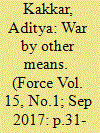

|
|
|
|
|
|
|
|